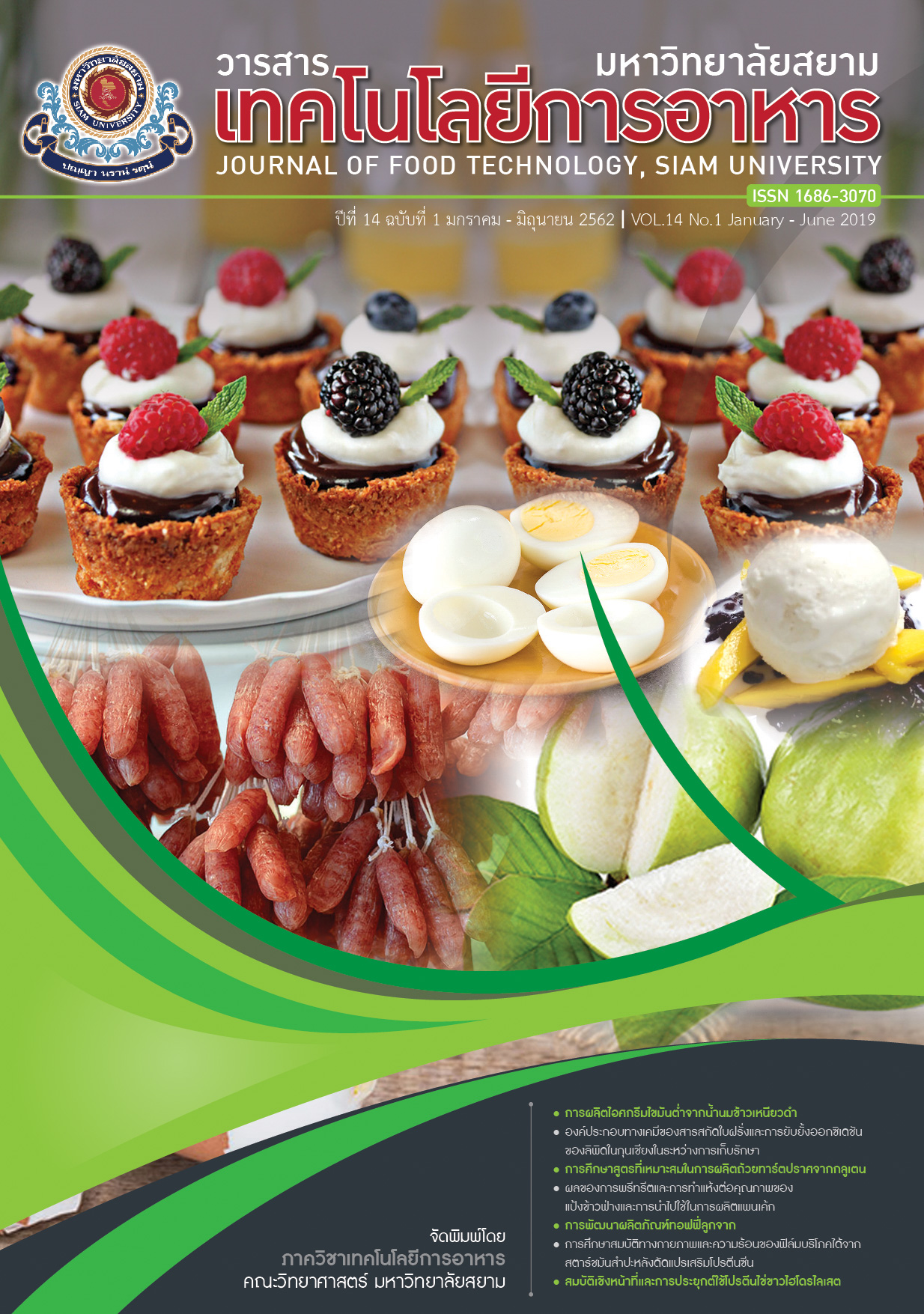Chemical Composition of Guava Leaf Extract and Lipid Oxidation Inhibition in Chinese Sausage During Storage
Main Article Content
Abstract
This research aims to study the chemical composition, antioxidative properties of the guava leaf extract powder and its antioxidant activities in Chinese sausage during storage at room temperature (30±3°C) for 28 days varying the guava leaf extract powder at 5 levels (0.05, 0.10, 0.15, 0.20 and 0.25 percent by pork meat weight) comparing with 0.01 percent synthetic antioxidants (BHT). The results showed that the value of lightness (L*), redness (a*) and yellowness (a*) of the extract of guava leaf powder with moisture content of 9.94 percent by wet basis were 46.64, 2.10 and 17.24 respectively. The amount of protein, fat, ash, fiber and carbohydrate were 6.89, 0.57, 11.16, 0.02 and 71.41 percent (dry basis), respectively. Total phenolic compounds were 273.98 mg Gallic Acid Equivalent /g extract. The radical scavenging activity by DPPH assay was 0.08 g DPPH/mg of sample which was statistically not significant difference (p>0.05) comparing with the radical scavenging activity of BHT (0.09 g DPPH/mg). When tracking the change of PV, TBA value and sensory evaluation of Chinese sausage, the results showed that Chinese sausage with 0.05 to 0.25 percent guava leaf extract powder had antioxidative properties comparing with control. However, it was lower than Chinese sausage with 0.01 percent BHT. In addition, Chinese sausage with 0.25 percent guava leaf extract and storage at 21 day was unacceptable from the consumers because of the reduction of sensory quality in the color attribute.
Article Details
Copyrights of all articles in the Journal of Food Technology available in print or online are owned by Siam University and protected by law.
References
[2] Bo, H., Jingsheng, H., Xiaoquan, B., Hong, Z., Xincheng, Y. and Youwei, W. (2011). Antioxidant activity of bovine and porcine meat treated with extracts from edible lotus (Nelumbo nucifera) rhizome knot and leaf. Meat Science. 87(1): 46-53.
[3] Liz, K., Keyla, L. and Kelly, J.K.G. (2013). Natural antioxidants in meat and poultry products. Meat Science. 94(2): 220-227.
[4] Okonogi, S., Duangrat, C., Chowwanapoonpohn, S. and Anuchapreeda, S. (2007). Research of antioxidant from Thai medicinal plants. National Research Council of Thailand.
[5] Pinsirodom, P. and Changnoi, W. (2002). Comparison of total phenolic compounds and anti-oxidant properties of extract from The seeds of the orange family that grown in Thailand. Food. 32: 300-307.
[6] AOAC. (2000). Office Method of Analysis of the Association of Official Chemist. 17th ed. Arlington, Virginia, USA.
[7] AOAC. (1994). Association of Official Analytical Chemists. Official Methods of Analysis. Washington, D.C.
[8] Schmedes, A. and Holmer.G. (1989). A new thiobarbituric acid (TBA) method for determining free malondialdehyde (MDA) and hydroperoxides selectively as a measure of lipid peroxidation. Journal of the American Oil Chemists' Society. 66(6): 813-817.
[9] Industrial Product Standards Act, B.E. 2539. (1996). Thai Industrial Standards Chinese sausage TISI. 914-2539. Bangkok.
[10] Naijitra, C. and Cheoymang, A. (2016). Evaluation of antioxidant activity, total phenolic and nicotine contents of 15 Thai Herbs. Science and Technology Journal. 24(2): 351-361.
[11] Tiempakdee, A., Hirun, S. and Utama-ang, N. (2012). Development of green tea production using vacuum infrared and heat pump techniques for technology transfers. Science and Technology Research Institute. Chiang Mai University.
[12] Boles, J.A., and Parrish Jr.F.C. (1990). Sensory and chemical characteristics of precooked microwave-reheatable pork roasts. Journal of Food Science. 55: 618–620.
[13] Rattanapanone, N. (2014). Food chemistry. Odeon Store Publisher, Bangkok. 504 p.
[14] Brand-Williams W, Cuvelier ME, Berset C. (1995). Use of a free radical method to evaluate antioxidant activity. Food Sci Tech. 28(1): 25-30.
[15] Govindarajan, S. 1973. Freash meat color. CRC Crit. Rev. Foodyechnol. 4, 117.


